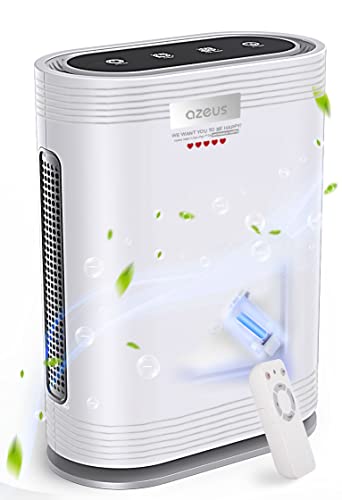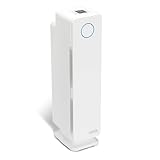Are you tired of sneezing and coughing in your own home? Do you want to breathe cleaner air that’s free from harmful pollutants? Investing in a UV air purifier might just be the solution for you. These nifty devices use ultraviolet light technology to effectively eliminate bacteria, mold, and other airborne contaminants. In this blog post, we’ll dive into what exactly a UV air purifier is, how it works, the different types available on the market today, factors to consider before buying one, as well as its pros and cons. We’ll also share tips for setting up your new device and answer some frequently asked questions about UV air purifiers. So sit back, relax and let us guide you through everything there is to know about choosing the best UV air purifier according to consumer reports!
Top 10 Uv Air Purifiers
*Note: Score is based on our AI score (Editor’s choice and rating).
What Is Uv Air Purifier?
A UV air purifier, also known as a UV-C air purifier or germicidal air cleaner, is a device that uses ultraviolet (UV) light technology to destroy harmful airborne particles such as bacteria, viruses, mold spores and other organic pollutants.
Unlike traditional filters that only trap contaminants in their fibers, UV air purifiers use short-wave ultraviolet light to break down the molecular structure of these microscopic organisms at the cellular level. This renders them unable to reproduce and ultimately kills them off.
What’s great about this technology is that it doesn’t produce any harmful byproducts- just clean air! The entire process occurs within the unit itself so there are no ozone emissions into your home.
While they may be slightly pricier than conventional HEPA-style filters upfront, they require less maintenance overall and provide better long-term results. Keep reading for more information on how these devices work and what you should consider when buying one.
How Does Uv Air Purifier Work?
UV air purifiers work by using ultraviolet-C (UVC) light to kill or deactivate airborne pathogens like bacteria and viruses. UVC light has a short wavelength that is capable of damaging the DNA and RNA of microorganisms, rendering them unable to reproduce or cause harm.
When you turn on your UV air purifier, it draws in contaminated air from the surrounding environment. The air passes through a pre-filter that captures larger particles like dust and pet dander before reaching the UVC lamp chamber. Here, the air is exposed to intense UVC light that kills any remaining microorganisms.
Once purified, the clean air is released back into your living space. Depending on the size of your UV air purifier and its efficiency rating, this process can occur multiple times per hour for maximum purification benefits.
It’s important to note that while UV air purifiers are effective at killing pathogens, they do not capture larger particles like pollen or smoke. For comprehensive filtration, consider pairing your UV air purifier with a HEPA filter unit for optimal results.
The Different Types of Uv Air Purifier
There are different types of UV air purifiers available in the market, each with its unique features and benefits. Here are some of them:
1. In-Duct UV Air Purifiers: These purifiers install directly into your HVAC system’s ductwork to clean the air as it circulates through your home or office. They use powerful lamps that emit short-wavelength ultraviolet (UV-C) light to kill viruses and bacteria.
2. Stand-Alone UV Air Purifiers: These purifiers come in portable designs that you can move from one room to another depending on where you need fresh air. They typically use fan-powered filters or electrostatic precipitators to capture dust, pollen, pet dander, and other particles while utilizing UV-C light technology.
3. Combination Filters: Some manufacturers combine HEPA filtration with UV technology for added effectiveness against airborne pathogens like viruses, bacteria and mold spores.
4. Commercial-Grade Models: These models feature higher intensity lamps compared to residential units; they’re designed specifically for use in hospitals, schools, offices or any large space requiring maximum purification capacity.
When choosing a type of UV air purifier suitable for you consider factors such as size of space being purified, cost of replacement bulbs/lamps/filters etc., maintenance requirements etc..
Factors to Consider Before Buying Uv Air Purifier
When considering purchasing a UV air purifier, there are several factors that you should keep in mind to ensure that you get the best product for your needs. First and foremost, it’s important to consider the size of the room or area where you’ll be using the air purifier. You need to choose an air purifier with adequate coverage for your space.
Another essential factor is the type of filter used by the UV air purifier. Different filters have different capabilities when it comes to filtering out pollutants such as dust, pollen, mold spores and bacteria. Ensure that you do thorough research on different types of filters before making a purchase decision.
The level of noise produced by an air purifier is also worth considering if you plan on using it in a bedroom or other quiet environment. Some models produce very little noise while others can be quite loud.
Take into account any additional features offered by various models such as automatic shut-off or remote control operation. All these factors will help guide you towards selecting the best UV Air Purifiers available in Consumer Reports today!
Benefits of Using Uv Air Purifier
Using a UV air purifier has numerous benefits for your health and well-being. One of the primary advantages is that these devices can effectively eliminate germs, bacteria, viruses, and other harmful airborne particles from the air in your home or office.
UV air purifiers work by using ultraviolet light to neutralize impurities in the air. This process not only removes pollutants but also helps reduce unpleasant odors caused by mold, mildew, pet dander, and cigarette smoke.
Another advantage of UV air purifiers is their ease of use and low maintenance requirements. These devices typically require minimal upkeep beyond periodic bulb replacement.
By improving indoor air quality with a UV air purifier, you may experience fewer allergy symptoms such as sneezing or coughing. Over time this could lead to better respiratory health and even improved sleep quality due to reduced nasal congestion.
Investing in a high-quality UV Air Purifier can provide peace of mind knowing that your family or employees are breathing clean indoor air free from harmful contaminants.
The Pros and Cons of Uv Air Purifier
Just like any other air purifier, UV air purifiers also come with their own set of pros and cons. Let’s take a look at some of them.
Pros:
Firstly, UV air purifiers are highly effective in killing bacteria and viruses that may be present in the air. This makes it an ideal option for people who suffer from allergies or respiratory issues.
Secondly, unlike traditional filters that simply trap pollutants, UV technology actually destroys them by breaking down their molecular structure. As a result, they do not release back into the environment once trapped inside the unit.
UV air purifiers require minimal maintenance as there are no filters to replace or clean regularly. This saves both time and money in the long run.
Cons:
One major drawback of using a UV air purifier is that it only addresses biological contaminants such as bacteria and viruses. It does not remove dust particles or allergens from the air which can still cause irritation to those suffering from allergies or asthma.
Another concern is that prolonged exposure to ultraviolet light can be harmful to human health and can even lead to skin cancer if proper precautions are not taken when operating the device.
While there are certainly benefits to using a UV air purifier, it’s important to weigh these against its potential drawbacks before making your final decision on whether this type of unit is right for you.
Tips For Setting Up Your Uv Air Purifier
Setting up your UV air purifier is crucial to ensure that it functions correctly and effectively. Here are some tips to help you set up your UV air purifier properly.
Firstly, choose the right location for your UV air purifier. It should be placed in a central location where the most airflow occurs, typically near doors or windows. Avoid placing it in areas with high humidity levels like bathrooms or kitchens.
Secondly, make sure that you read the manufacturer’s instructions carefully before setting up your device. This will help you understand how to install and operate it correctly.
Next, replace the filters regularly as per the manufacturer’s recommendations. Dirty filters can reduce airflow and affect the effectiveness of your UV air purifier.
It’s also important to keep other sources of pollutants at bay by maintaining cleanliness in your surroundings. Vacuum carpets often, clean surfaces frequently, avoid smoking indoors and minimize clutter which can harbor dust mites.
Regular maintenance is necessary for optimal functioning of any appliance; therefore schedule cleaning every few months depending on usage patterns.
By following these tips and keeping an eye out for any issues that may arise during operation,you can ensure that your UV air purifier runs smoothly while providing clean indoor air quality all year round!
FAQs
FAQs:
Q: Can UV air purifiers eliminate all types of air pollutants?
A: While UV air purifiers are effective at killing germs and bacteria, they may not be as effective at removing other types of pollutants such as dust, pollen, or pet dander. It’s important to choose a unit that can effectively filter out the specific contaminants you want to remove from your indoor environment.
Q: Are there any safety concerns associated with using UV air purifiers?
A: Yes, direct exposure to UV-C radiation can be harmful to humans and pets. However, most units on the market today have built-in safety features that prevent accidental exposure.
Q: How often do I need to replace the bulbs in my UV air purifier?
A: The lifespan of the bulbs will depend on usage and quality but generally ranges from 6 months up to 2 years. It’s important to follow the manufacturer’s guidelines for replacement intervals.
Q: Can I use a UV air purifier in conjunction with other types of air filters?
A: Absolutely! In fact, combining different types of filters can provide more comprehensive filtration and improve overall indoor air quality. Just make sure you select compatible products that won’t hinder each other’s performance.
Q: Will a large room require a larger capacity UV Air Purifier?
A: Yes, it is recommended that you choose an appropriately sized unit based on the square footage of your space. Always check manufacturer specifications before purchasing an item like this one.
Conclusion
After reviewing the different types of UV air purifiers, factors to consider before making a purchase, and the benefits and drawbacks of using one, it is clear that these devices can provide significant advantages for those looking to improve their indoor air quality.
When searching for the best UV air purifier consumer report, it’s important to take into account your specific needs and budget. Look for models with high efficiency ratings and multiple stages of filtration. Consider room size coverage as well as noise levels when choosing a unit.
Investing in a quality UV air purifier can be a wise decision that provides cleaner air in your home or office space. By following the tips provided in this guide, you’ll be better equipped to make an informed decision on which type of device will work best for you. And with improved indoor air quality comes improved overall health and wellbeing!
I’m Ella Andrews, owner of the website https://bestconsumerstips.com/
I give you valuable information about good products to help you choose the best product.











